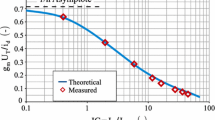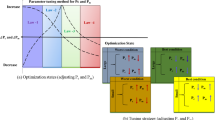Abstract
Modern time microwave stages require low power consumption, low size, low-noise amplifier (LNA) designs with high-performance measures. These demands need a single transistor LNA design, which is a challenging multi-objective, multi-dimensional optimization problem that requires solving objectives with non-linear feasible design target space, that can only be achieved by optimally selecting the source (ZS) and load (ZL) terminations. Meta-heuristic algorithms (MHAs) have been extensively used as a search and optimization method in many problems in the field of science, commerce, and engineering. Since feasible design target space (FDTS) of an LNA transistor (NE3511S02 biased at VDS = 2 V and IDS = 7 mA) is a multi-objective multi-variable optimization problem the MHA can be considered as a suitable choice. Three different types of grey wolf variants inspired algorithms had been applied to the LNA FDTS problem to obtain the optimal source and load terminations that satisfies the required performance measures of the aimed LNA design. Furthermore, the obtained results are justified via the use of the Electromagnetic Simulator tool AWR. As a result, an efficient optimization method for optimal determination of ZS and ZL terminations of a high-performance LNA design had been achieved.








Similar content being viewed by others
References
Gunes, F., Belen, M. A., & Mahouti, P. (2018). Competitive evolutionary algorithms for building performance database of a microwave transistor. International Journal of Circuit Theory and Applications, 46(2), 244–258.
Gunes, F., Uluslu, A., & Mahouti, P. (2020). Pareto optimal characterization of a microwave transistor. IEEE Access, 8, 47900–47913.
Gunes, F., Gunes, M., & Fidan, M. (1994). Performance characterisation of a microwave transistor. IEE Proceedings-Circuits, Devices and Systems, 141(5), 337–344.
Gunes, F., & Cetiner, B. A. (1998). Smith chart formulation of performance characterisation for a microwave transistor. IEE Proceedings-Circuits, Devices and Systems, 145(6), 419–428.
Demirel, S., & Gunes, F. (2013). Performance characterisation of a microwave transistor for the maximum output power and the required noise. IET Circuits, Devices & Systems, 7(1), 9–20.
Gunes, F., & Demirel, S. (2016). Performance characterization of a microwave transistor subject to the noise and matching requirements. International Journal of Circuit Theory and Applications, 44(5), 1012–1028.
Gunes, F., Ozkaya, U., & Demirel, S. (2009). Particle swarm intelligence applied to determination of the feasible design target for a low-noise amplifier. Microwave and Optical Technology Letters, 51(5), 1214–1218.
Gunes, F., Demirel, S., & Mahouti, P. (2016). A simple and efficient honey bee mating optimization approach to performance characterization of a microwave transistor for the maximum power delivery and required noise. International Journal of Numerical Modelling: Electronic Networks, Devices and Fields, 29(1), 4–20.
Belen, M. A., Alic, M., Cor, A., & Gunes, F. (2014). Performance characterization of a microwave transistor using firefly algorithm. In Proceedings of the symposium in the electrical and electronics computer engineering (ELECO) (pp. 491–493). Bursa, Turkey.
Kiani, F., Rad, A., Sis, M. K., Kut, A., & Alpkocak, A. (2013). EEAR: An energy effective-accuracy routing algorithm for wireless sensor networks. Life Science Journal, 10(2), 39–45.
Kiani, F., Nematzadehmiandoab, S., & Seyyedabbasi, A. (2019). Designing a dynamic protocol for real-time Industrial Internet of Things-based applications by efficient management of system resources. Advances in Mechanical Engineering, 11(10), 1687814019866062.
Seyyedabbasi, A., Dogan, G., & Kiani, F. (2020). HEEL: A new clustering method to improve wireless sensor network lifetime. IET Wireless Sensor Systems, 10(3), 130–136.
Gunes, F., Demirel, S., & Mahouti, P. (2014). Design of a front–end amplifier for the maximum power delivery and required noise by HBMO with support vector microstrip model. Radioengineering, 23(1), 134–143.
Talbi, E. G. (2009). Metaheuristics: From design to implementation (Vol. 74). Wiley.
Guney, K., & Onay, M. (2008). Bees algorithm for design of dual-beam linear antenna arrays with digital attenuators and digital phase shifters. International Journal of RF and Microwave Computer‐Aided Engineering: Co‐sponsored by the Center for Advanced Manufacturing and Packaging of Microwave, Optical, and Digital Electronics (CAMPmode) at the University of Colorado at Boulder, 18(4), 337–347.
Galehdar, A., Thiel, D. V., Lewis, A., & Randall, M. (2009). Multiobjective optimization for small meander wire dipole antennas in a fixed area using ant colony system. International Journal of RF and Microwave Computer-Aided Engineering: Co‐sponsored by the Center for Advanced Manufacturing and Packaging of Microwave, Optical, and Digital Electronics (CAMPmode) at the University of Colorado at Boulder, 19(5), 592–597.
Glover, F. W., & Kochenberger, G. A. (Eds.). (2006). Handbook of metaheuristics (Vol. 57). Springer.
Yildirim, A., Gunes, F., & Belen, M. A. (2017). Differential evolution optimization applied to the performance analysis of a microwave transistor. Sigma Journal of Engineering and Natural Sciences, 8(2), 135–144.
Mahouti, P. (2019). Design optimization of a pattern reconfigurable microstrip antenna using differential evolution and 3D EM simulation-based neural network model. International Journal of RF and Microwave Computer‐Aided Engineering, 29(8), e21796.
Belen, A., Güneş, F., Belen, M. A., & Mahouti, P. (2020). 3D printed wideband flat gain multilayer nonuniform reflectarray antenna for X-band applications. International Journal of Numerical Modelling: Electronic Networks, Devices and Fields, 33(6), e2753.
Belen, A., Mahouti, P., Güneş, F., & Tari, Ö. (2021). Gain enhancement of a traditional horn antenna using 3D printed square-shaped multi-layer dielectric lens for X-band applications. Applied Computational Electromagnetics Society Journal, 36(2), 132–138.
Belen, A., & Günes¸, F., & Mahouti, P., (2020). Design optimization of a dual-band microstrip SIW antenna using differential evolutionary algorithm for X and K-band radar applications. ACES Journal, 35(7), 778–783.
Mirjalili, S., Mirjalili, S. M., & Lewis, A. (2014). Grey wolf optimizer. Advances in Engineering Software, 69, 46–61.
Seyyedabbasi, A., Aliyev, R., Kiani, F., Gulle, M., Basyildiz, H. & Shah, M. (2021). Hybrid algorithms based on combining reinforcement learning and metaheuristic methods to solve global optimization problems. Knowledge-Based Systems, 223, 1–22.
Kaveh, A., & Shokohi, F. (2016). Application of grey wolf optimizer in design of castellated beams. Asian Journal Of Civil Engıneering (BHRC), 17(5), 683–700.
Emary, E., Zawbaa, H. M., Grosan, C., & Hassenian, A. E. (2015). Feature subset selection approach by gray-wolf optimization. Afro-European Conference for Industrial Advancement Springer, 334, 1–13.
Kiani, F., Seyyedabbasi, A., Aliyev, R., Shah, MA. & Gulle, M. (2021). 3D path planning method for multi-UAVs inspired by grey wolf algorithms. Journal of Internet Technology, 22(4), 1–12.
Muro, C., Escobedo, R., Spector, L., & Coppinger, R. P. (2011). Wolf-pack (Canis lupus) hunting strategies emerge from simple rules in computational simulations. Behavioural Processes, 88(3), 192–197.
Seyyedabbasi A. & Kiani F. (2021). I-GWO and Ex-GWO: Improved algorithms of the Grey Wolf Optimizer to solve global optimization problems. Engineering with Computers, 37, 509–532.
Author information
Authors and Affiliations
Corresponding author
Additional information
Publisher’s Note
Springer Nature remains neutral with regard to jurisdictional claims in published maps and institutional affiliations.
Rights and permissions
About this article
Cite this article
Kiani, F., Seyyedabbasi, A. & Mahouti, P. Optimal characterization of a microwave transistor using grey wolf algorithms. Analog Integr Circ Sig Process 109, 599–609 (2021). https://doi.org/10.1007/s10470-021-01914-y
Received:
Revised:
Accepted:
Published:
Issue Date:
DOI: https://doi.org/10.1007/s10470-021-01914-y




